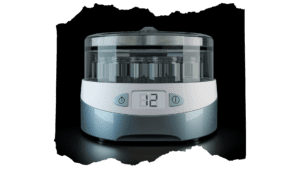Now I think we can all agree that fermenting is a whole new world, but the finished process is unbelievably delicious! And it really isn’t as confusing as a lot of people will think! in fact, if more people knew how to make yoghurt, I’m sure everyone would be doing it! As soon as you wrap your head around the process, and what things you need to be looking out for, You’ll be fermenting easier than… someone who is really good at fermenting? (Sorry there’s not a lot of well know fermentation Connoisseurs)
However, with all that being said, there are some factors that can be detrimental to the survival of your starter culture (And New Best Friend). So here is 8 Things I Wish I knew Before Making Yoghurt!
How do you know if a Yoghurt is not safe to eat?
Keep an eye out for any discolouration! if you see any orange or pinkish colours, DO NOT EAT IT!!! this is an indication it has contracted listeria. Listeria can be incredibly bad for you, and make you very ill, so we would always advise throwing this culture away. DO NOT RECULTURE, Just buy another culture, or give us a call so we can help you identify what the issue may have been.
A great way to avoid ever having to deal with this, is by making sure that everything that comes in contact with that yoghurt starter has been thoroughly cleaned, and isn’t dirty. Bad bacteria can make their way into the culture if the equipment that you’re using is not clean.
What Is The Difference Between Mesophilic and Thermophilic?
Mesophilic will ferment at room temperature, and Thermophilic requires a yoghurt maker to ferment. To make it easy for you, we mark all of our starters with a sticker indicating if it needs a yoghurt maker or not.
You need to make sure that you know exactly what type of yoghurt starter you are buying before you purchase it, because the last thing you want to do is buy a starter culture and find out you don’t have the correct equipment for it.
What is an Heirloom Yoghurt? and why are they better than Non-Heirloom?
Heirloom means that the yoghurt starter can be recultured infinitely, and will keep working as long as you keep it going! however, I wouldn’t say that it is particularly better, as Russian yoghurt is delicious and Non Heirloom!
What is the Best Yoghurt Starter that Freshly Fermented Sell?
It really depends on your personal taste. however, if we’re going by popularity, Bulgarian, Greek, Caspian Sea and Villi are some of our most popular yoghurts. However, if you need a specific yoghurt, and are unsure of what starter you will need, give us a call, and we would be happy to assist you further!
What Is The Best Temperature to leave your yoghurts starter at while it ferments?
It’s quite simple and again, depends on what starter you have brought:
Mesophilic: 21 Celsius (79.8 fahrenheit)
Thermophilic: 42 Celsius (107.6 fahrenheit)
With the mesophilic, you do get a bit of leeway! so between 18 Celsius (64.4 Fahrenheit) and 23 Celsius (73.4 Fahrenheit) should keep it steady, but you should still aim for 21 Celsius (79.7 Fahrenheit)
What does it mean if my yoghurt has separated into curds and whey?
Curds and Whey is a sign of an over fermented yoghurt. it has not gone bad, it just needs to be fermented for a bit less time than before. if you are adamant about eating your yoghurt, you can just pour some of the whey out, and mix it together to get your ideal consistency!
How long will a yoghurt last before it needs to be recultured?
Follow the info below to calculate if your yoghurt can be recultured or not:
1-7 Days / Ideal Time
8-9 Days / Risky but should work
10-14 days / low chance but possible
2+ weeks / dead culture
What Starter is the same as the yoghurt sold in supermarkets?
The Bulgarian is the most popular yoghurt, and is the one that popular brands like Muller use in their yoghurts!
To check out Lakeland yoghurt makers, click here
Powered by BetterDocs